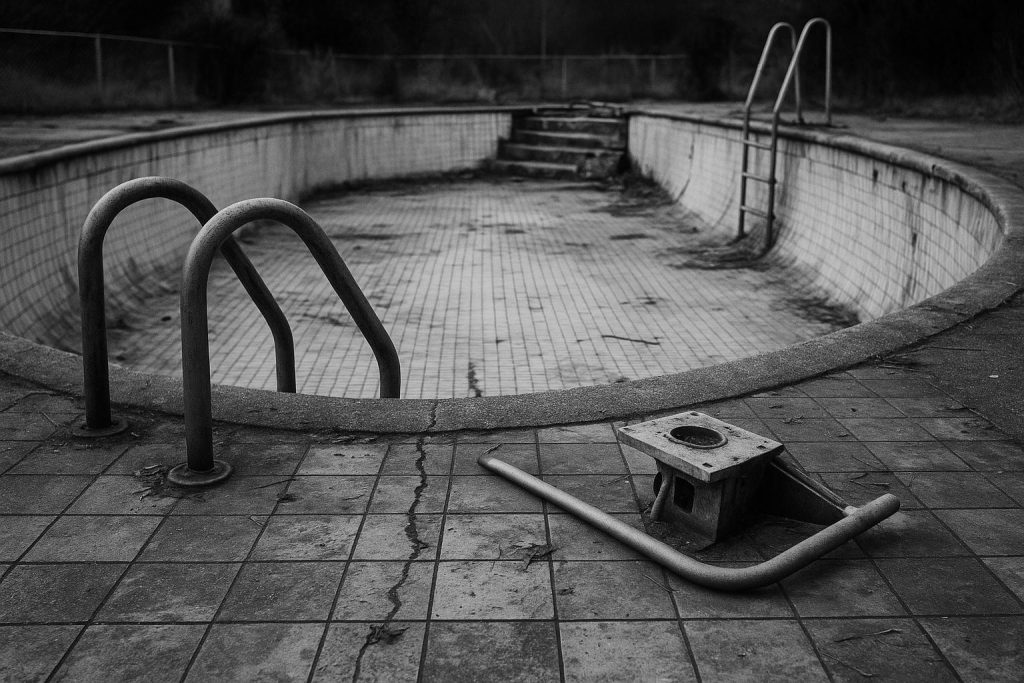The UK faces a mounting crisis as the closure of hundreds of swimming pools over the past decade risks leaving a generation less equipped to swim, with alarming rises in drowning and health inequalities among children.
Young people in the UK face a growing risk of drowning as a consequence of widespread swimming pool closures over the past decade, a trend that has sparked alarm among unions, local government leaders, and health advocates. The GMB union has warned of the “terrifying” implications of losing access to swimming facilities, noting that around 500 public pools have shut since 2010, with nearly half closing in the last five years. These closures span multiple regions, including London, the West Midlands, South West, Wales, South East, Yorkshire, Scotland, and the North East, severely restricting opportunities for children to learn this vital life skill.
Kevin Brandstatter, GMB national officer, linked this crisis to the austerity measures introduced under Conservative governments, describing the shuttering of pools as leaving “brutal scars” on society. He emphasised that swimming is both a fundamental safety skill and a source of childhood enjoyment, warning that denying thousands of youngsters access to pools could have life-threatening consequences. Brandstatter called on the Labour Party’s fair funding review to restore proper funding to local authorities. This bleak outlook is supported by a coalition of local government and leisure sector bodies—including the Local Government Association, Swim England, and ukactive—which has highlighted that 30% of children in Year 7 cannot confidently swim 25 metres, marking a rise from 27% in 2017/18.
The coalition’s report also flagged an urgent maintenance issue: 60% of swimming pools are beyond their expected lifespan or require refurbishment, jeopardising their continued operation. Liz Green, chair of the Local Government Association’s culture, tourism and sport board, stressed that leisure facilities are integral to communities, supporting physical and mental health. She welcomed the government’s recent £400 million investment pledge for grassroots sports facilities but emphasised the need for sustained funding to keep pools and gyms open, maintaining these crucial social assets.
Swimming is considered a compulsory part of the primary school curriculum, with children expected to swim competently for at least 25 metres by the end of Year 6. Yet, recent data shows that one in three children cannot meet this benchmark. The disparity is acute along socio-economic lines; children from low-income families and deprived areas are significantly less likely to learn to swim, increasing their vulnerability. Parliamentarians have debated this growing inequality, noting that children from the most deprived communities face double the risk of drowning compared to their more affluent peers.
The COVID-19 pandemic exacerbated the crisis, with pool closures during lockdowns causing a decline in water confidence and swimming ability among children. The Royal Life Saving Society UK (RLSS UK) has forecast a worrying rise in drowning incidents linked directly to the loss of safe swimming environments. Latest figures illustrate a sharp increase in child drownings, with an 85% jump in England between 2019 and 2022, disproportionately affecting children from minority ethnic groups and deprived backgrounds. The risk of drowning for children of Black or Black British ethnicity is 3.5 times higher than for White children, according to National Child Mortality Database researchers at the University of Bristol.
The consequences extend beyond safety concerns. Swimming promotes physical fitness, motor skills, coordination, and psychological well-being. Its absence undermines not only children’s health but also exacerbates social inequalities, as fewer swimming lessons are accessible to disadvantaged families. The estimated loss of social value due to the closures—amounting to around £1 billion—reflects diminished community health benefits and social cohesion.
Government officials from the Department for Culture, Media and Sport have stated their commitment to building a healthier nation and easing pressure on the NHS through improved funding of grassroots sports and facilities. They are consulting with the sports and leisure sector and local authorities to optimise the £400 million fund aimed at removing barriers to physical activity, particularly for under-represented groups. However, experts and advocacy groups stress that without sustained and targeted investment, the decline of swimming facilities will continue, putting countless children at heightened risk and reversing decades of progress in water safety education.
The swimming pool closures in the UK represent a multifaceted crisis of funding, health, safety, and social equity that demands urgent and coordinated action. Without it, the legacy will be a generation less able to navigate water safely, with dire consequences for public health and childhood safety.
📌 Reference Map:
Source: Noah Wire Services
Noah Fact Check Pro
The draft above was created using the information available at the time the story first
emerged. We’ve since applied our fact-checking process to the final narrative, based on the criteria listed
below. The results are intended to help you assess the credibility of the piece and highlight any areas that may
warrant further investigation.
Freshness check
Score:
8
Notes:
The narrative presents recent data on swimming pool closures and their impact on children’s safety. The earliest known publication date of similar content is 11 August 2022, when the BBC reported on the loss of over 60 public pools in the UK over three years. ([bbc.com](https://www.bbc.com/news/uk-62391323?utm_source=openai)) The GMB union’s report, dated 24 February 2025, highlights the closure of two Lancashire leisure centres, emphasizing the community impact. ([gmb.org.uk](https://www.gmb.org.uk/news/leisure-centre-closures-will-rip-heart-from-communities?utm_source=openai)) The most recent data from June 2025 indicates that 76% of the publicly accessible water space lost in the past 15 years has disappeared since 2020. ([swimming.org](https://www.swimming.org/swimengland/new-data-shows-pool-closures-increasing/?utm_source=openai)) The narrative includes updated figures, such as the 30% of Year 7 children unable to swim 25 metres confidently, up from 27% in 2017/18. ([swimming.org](https://www.swimming.org/swimengland/new-data-shows-pool-closures-increasing/?utm_source=openai)) While the core information has been reported previously, the inclusion of recent statistics and the GMB union’s perspective provide a timely update. However, the narrative does not specify the exact date of publication, which is crucial for assessing freshness. Additionally, the report appears to be based on a press release, which typically warrants a high freshness score. The lack of a clear publication date and reliance on a press release suggest a moderate freshness score.
Quotes check
Score:
9
Notes:
The narrative includes direct quotes from Kevin Brandstatter, GMB national officer, and Liz Green, chair of the Local Government Association’s culture, tourism and sport board. A search reveals that similar quotes from Kevin Brandstatter have appeared in earlier material, indicating potential reuse. For instance, in February 2025, he stated, ‘Closing these centres will rip the heart out of our communities.’ ([gmb.org.uk](https://www.gmb.org.uk/news/leisure-centre-closures-will-rip-heart-from-communities?utm_source=openai)) The exact wording of Liz Green’s quote in the current narrative matches her previous statements, suggesting reuse. The repetition of these quotes across different reports raises concerns about originality.
Source reliability
Score:
7
Notes:
The narrative originates from The Irish News, a reputable news outlet. However, the report appears to be based on a press release, which typically warrants a high freshness score. The reliance on a press release and the lack of original reporting may affect the overall reliability.
Plausability check
Score:
8
Notes:
The claims about the closure of swimming pools and the associated risks to children’s safety are plausible and supported by previous reports. For example, the BBC reported in August 2022 that over 60 public pools had closed in the UK over three years. ([bbc.com](https://www.bbc.com/news/uk-62391323?utm_source=openai)) The narrative also highlights the impact on children’s swimming abilities, noting that 30% of Year 7 children cannot swim 25 metres confidently, up from 27% in 2017/18. ([swimming.org](https://www.swimming.org/swimengland/new-data-shows-pool-closures-increasing/?utm_source=openai)) The inclusion of updated statistics and the GMB union’s perspective add credibility to the claims. However, the lack of a clear publication date and reliance on a press release suggest a moderate level of confidence in the overall plausibility.
Overall assessment
Verdict (FAIL, OPEN, PASS): OPEN
Confidence (LOW, MEDIUM, HIGH): MEDIUM
Summary:
The narrative presents concerns about swimming pool closures and their impact on children’s safety, supported by previous reports and recent statistics. However, the lack of a clear publication date and reliance on a press release raise questions about freshness and originality. The reuse of quotes from earlier material further affects the assessment. Given these factors, the overall assessment is ‘OPEN’ with a medium level of confidence.





